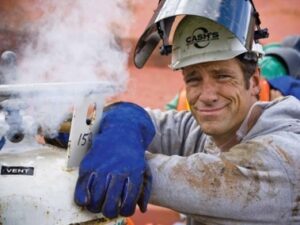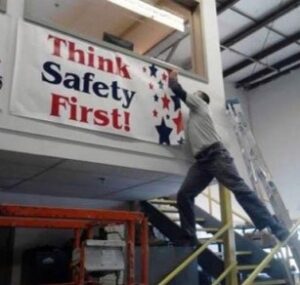Jim Schuster
Martin Technical, Inc.
05/26/2018
 Industrial safety is not a glamorous, and there really aren’t any household names that are recognized across the industry, so when a celebrity talks about safety on a national tv show it’s pretty much the pinnacle of exposure for the safety industry. Mike Rowe of Dirty Jobs fame has been a proponent of skilled labor and safety for a long time, and recently he was speaking about his “Safety Third” philosophy on the Tucker Carlson Tonight show. In this clip at the 1:55 mark, Mike Rowe explains his view of safety and the expectations of what happens when we elevate the values of safety to “Safety First”.
Industrial safety is not a glamorous, and there really aren’t any household names that are recognized across the industry, so when a celebrity talks about safety on a national tv show it’s pretty much the pinnacle of exposure for the safety industry. Mike Rowe of Dirty Jobs fame has been a proponent of skilled labor and safety for a long time, and recently he was speaking about his “Safety Third” philosophy on the Tucker Carlson Tonight show. In this clip at the 1:55 mark, Mike Rowe explains his view of safety and the expectations of what happens when we elevate the values of safety to “Safety First”.
As Mike explains, it’s not that safety isn’t important, but rather that “Safety First” can set expectations that somebody else in charge cares more about your safety and well-being than you do, and that if you just follow their processes, you will be safe. This is an excellent point as transferring your safety to another person or process can lead to complacency and reduce safety to background noise in your daily work. By stating “Safety Third”, Mike is trying to start a conversation and make people think instead of just following a rule or checking a box for their safety. This is much like the approach of posting speed limit signs at “14 Miles Per Hour” instead of the common “15” which is just enough of a deviation that it makes people stop, take notice and process their actions.
Where Mike is right is that the first line of safety is personal responsibility and self-awareness, which should be practiced always and not just when going through mandatory safety checks. What we are talking about is a hot topic in the industry; safety behavior. The challenge however is the complex set of traits for each individual and changing the behavior of each individual. Each person has their own physical and cognitive abilities, values, risk tolerance and behavior and the expectations of having everyone on the same level of personal responsibility for safety simply isn’t realistic. Guys like Mike are smart and experienced, but we also have to deal with the 22-year-old rock climber that would prefer to scale the racking system instead of using a forklift (yes, this was a real situation), or the new worker who just started and is afraid to ask which valve to turn in fear of looking incompetent and getting fired. So even though an individual may exercise good personal safety behavior, it’s not enough as they are still subject to others in their environment who don’t have the same abilities or care and may create a dangerous situation for those near them.
So despite best efforts by any individual to assess the risks and take safety into their own hands, we don’t always have control of unexpected events such as the co-worker turning the wrong valve on, a machine failing, or to bring it home to a level that everyone can relate to; a driver absent mindedly running a red light. This is why we wear seat belts; not that we are expecting ourselves to fail, but for the unexpected failure of another person or machine or unplanned circumstances such as hydroplaning on an oil glistening street after a light rain. And with this comes safety precautions, processes, checklists, and training to the point of numbness, which is where we pick it back up with Mike.
 The infinity of safety procedures, signs and training is required to provide the knowledge and awareness to the workers for their safety and has statistically proven to greatly reduce injuries, so it’s not that this needs to go away as much as the volume of it or repetitiveness of it can seem like a process running in the background that creates an environment of complacency. Routine creates comfort, and as long as there is no incidents, the routine actions, safety processes and training disappear further and further into the background.
The infinity of safety procedures, signs and training is required to provide the knowledge and awareness to the workers for their safety and has statistically proven to greatly reduce injuries, so it’s not that this needs to go away as much as the volume of it or repetitiveness of it can seem like a process running in the background that creates an environment of complacency. Routine creates comfort, and as long as there is no incidents, the routine actions, safety processes and training disappear further and further into the background.
So how do we make safety more relevant and important? The key is bringing things home to a personal level and expanding beyond the forms and processes and into individual responsibility. Mike has done an excellent job with his crew by stating “Safety Third” which everyone knows that the expectation is that safety is your hands and not to count on a company, process or another individual for your safety. It is a big leap of faith for a safety manager to state that they are not responsible for your safety and put the responsibility back on the individual, but it’s a conversation that needs to happen. And to expand upon that, individuals need to know they are also responsible for the safety of others, which is how you build a true and proper safety culture. Further, safety needs to be personally relevant to be understood and practiced. Informing workers of codes and standards isn’t enough. Mike’s safety failures have resulted in numerous injuries, which
The other part that makes Mike program successful is his personal failures and his ability to transfer that to others. Mike is safety nut because he has had short mental lapses that resulted in injuries and forced him to re-think his safety and the safety of his crew. His scars and broken bones tell a story that make it personal and that others can relate to. This makes people stop and evaluate their personal situation instead of simply following processes, which is the whole point of Mike’s approach. Safety needs to be on a personal level and informing someone about a code will never have as much impact as an emotional connection to someone’s job and the realization that they or a co-worker may not make it home this evening.
As odd as it may seem, “Safety 3rd” may be a good mantra for developing a strong safety culture at your plant or facility by disrupting the routine and reminding everyone that safety may be the priority of the company or organization, but ultimately you can’t count on others for your safety and need to take responsibility for yourself and your co-workers. Safety managers can provide you all the training, tools and procedures you could ever need, but it you don’t use them and take personal responsibility….that’s on you.
We are here to help you.